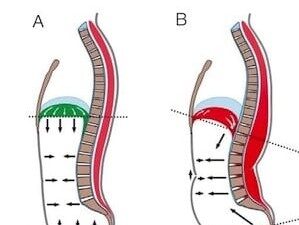Air Flow Dysfunction = Pelvic Dysfunction
- Justina

If you CAN NOT get air into the back of your lungs, you CAN NOT get into a posterior pelvic tilt. Air and pressure should flow and mobilize the back of lungs and back of the pelvis. When you are unable to do this or sense this, it becomes a pressure problem that results in back (herniated disks, arthritis) and pelvic floor concerns (prolapse, pain). When you can’t control this aspect inside of yourself, it will present itself on the outside of your body with a flat upper spine and rigid pelvis.
Air flow dysfunction causes mechanical dysfunction. If you can’t control the pressure back, it has to go somewhere and could quite possibly cause a pelvic floor prolapse. So women who undergo an operation to fix a pelvic floor issue, but did not address the pressure and breathing issues can find themselves back in the operation room quite easily for more repairs. Most people who can’t poo have a pelvis that they can’t position into a posteriorly tilt nor can they breathe into their back lungs. The force of pulling the body forward causes the sphincters to tighten. Breathing into the back of your lungs allows the body to receive signals from mechanoreceptors on the bottom of your feet so you can have better balance and strength.
The first step is to SENSE airflow being directed into the back of your lungs, the posterior mediastinum. The easiest way to do this is lying on your back with your shins resting on a chair. When you breathe into the back of your lungs, it expands the back of your chest wall. The spine decompresses and slightly presses back on the inhalation phase of breathing. Expanding your posterior back is not the same as flexing or bending the spine; it is the natural shape of the upper back which allows diaphragmatic breathing and coordinates with pelvic floor activation. Inhaling with proper mechanics will increase the heart rate, slow digestion, and inhibit the parasympathetic system. The exhalation done with diaphragmatic breath will decrease heart rate, increase digestion and stimulate the parasympathetic system.
When you exhale, your ribcage internally rotates and goes back which makes it shrink and pull together with the internal oblique (side ab wall) of the abdominals that wrap around bottom of front ribs to top of back pelvis. If your ribs are popping, or sticking out, you are stuck in the inhale phase and pelvis is being pulled into an anterior tilt.
You need to go back before you can go forward. Think of how you lower yourself to the ground before you jump up, or swing your arms back before you jump forward. We need air to move into our back so we can move forward in our walks. Feel air leave the body calmly, comfortably, and completely to prepare the body for inhalation. It is the oscillation of life.
